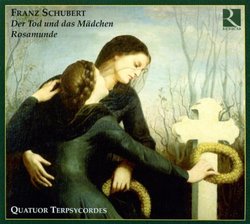Exceptional Schubert...
Sébastien Melmoth | Hôtel d'Alsace, PARIS | 03/20/2009
(5 out of 5 stars)
".
Exceptional Schubert...
.
This release on the French Ricercar label was recorded in Switzerland in 2007 by the historical performance practice ensemble Quatuor Terpsycordes
(wordplay on Terpsichore, the muse of the dance).
Using 19th Century instruments with gut strings and classical bows, the group takes A=430Hz (presumably a popular pitch c.1825).
"The curve and weight of historical bows when used on these strings creates a palette of articulations that links the notes with a play of consonants that is related to vocal production."
This segues into the group's realization of these Quartets within the purview of Schubert's ethos of the Lied.
Much of Schubert's art is predicated on the ethos of the Lied--which particularly pervades these two Quartets in self-intertextuality from the songs "Der Tod und das Mädchen," D.531, "Die Götter Griechenlands," D.677, "Gretchen am Spinnrade," D.118, and "Erlkönig," D.328.
There is an engaging resonance in the gut string timbre and the instruments' vocalizations are excellent.
The performers give the texts time to breathe but are crisp in the event.
Their avowed intention is to dwell in the moment and relish the indeterminacy of exitence (in the ontological sense): this is realized musically in their conjugation of micro-variation as tones are birthed, grow, decay, and die away.
Some have tried to invest allegorical poetics of Death in these two minor-key Quartets--which is a two-edged sword: for though
"Cowards die many times before their deaths;
The valiant never taste of death but once.
Of all the wonders that I yet have heard,
It seems to me most strange that men should fear,
Seeing that death, a necessary end,
Will come when it will come";
nevertheless, to the living, Death is an ugly thing.
It may be an aesthetic mistake to read too much Todestrieb (desire for oblivion = Thanatos) into the music when the actual sensual activity of auditing Schubert's unique melodies, harmonies, and timbres is distinctly a life-affirming pleasure in terms of Eros.
These two Quartets are exceptional masterpieces in Schubert's exquisite oeuvre, and the sheer expressiveness of this reading will affect the most discriminating aficionado.
The recording is equitably miked and there is a nice ambience to the locale's sonics.
TT: 76'58"
."


 Track Listings (8) - Disc #1
Track Listings (8) - Disc #1